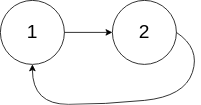英文原文
Given the head of a linked list, return the node where the cycle begins. If there is no cycle, return null.
There is a cycle in a linked list if there is some node in the list that can be reached again by continuously following the next pointer. Internally, pos is used to denote the index of the node that tail's next pointer is connected to (0-indexed). It is -1 if there is no cycle. Note that pos is not passed as a parameter.
Do not modify the linked list.
Example 1:

Input: head = [3,2,0,-4], pos = 1 Output: tail connects to node index 1 Explanation: There is a cycle in the linked list, where tail connects to the second node.
Example 2:

Input: head = [1,2], pos = 0 Output: tail connects to node index 0 Explanation: There is a cycle in the linked list, where tail connects to the first node.
Example 3:

Input: head = [1], pos = -1 Output: no cycle Explanation: There is no cycle in the linked list.
Constraints:
- The number of the nodes in the list is in the range
[0, 104]. -105 <= Node.val <= 105posis-1or a valid index in the linked-list.
Follow up: Can you solve it using O(1) (i.e. constant) memory?
中文题目
给定一个链表,返回链表开始入环的第一个节点。 如果链表无环,则返回 null。
如果链表中有某个节点,可以通过连续跟踪 next 指针再次到达,则链表中存在环。 为了表示给定链表中的环,评测系统内部使用整数 pos 来表示链表尾连接到链表中的位置(索引从 0 开始)。如果 pos 是 -1,则在该链表中没有环。注意:pos 不作为参数进行传递,仅仅是为了标识链表的实际情况。
不允许修改 链表。
示例 1:

输入:head = [3,2,0,-4], pos = 1 输出:返回索引为 1 的链表节点 解释:链表中有一个环,其尾部连接到第二个节点。
示例 2:

输入:head = [1,2], pos = 0 输出:返回索引为 0 的链表节点 解释:链表中有一个环,其尾部连接到第一个节点。
示例 3:

输入:head = [1], pos = -1 输出:返回 null 解释:链表中没有环。
提示:
- 链表中节点的数目范围在范围
[0, 104]内 -105 <= Node.val <= 105pos的值为-1或者链表中的一个有效索引
进阶:你是否可以使用 O(1) 空间解决此题?
通过代码
高赞题解
解题思路:
- 这类链表题目一般都是使用双指针法解决的,例如寻找距离尾部第K个节点、寻找环入口、寻找公共尾部入口等。
算法流程:
- 双指针第一次相遇: 设两指针
fast,slow指向链表头部head,fast每轮走 $2$ 步,slow每轮走 $1$ 步;
- 第一种结果:
fast指针走过链表末端,说明链表无环,直接返回null;
- TIPS: 若有环,两指针一定会相遇。因为每走 $1$ 轮,`fast` 与 `slow` 的间距 $+1$,`fast` 终会追上 `slow`;
- 第二种结果: 当
fast == slow时, 两指针在环中 第一次相遇 。下面分析此时fast与slow走过的 步数关系 :
- 设链表共有 $a+b$ 个节点,其中 **链表头部到链表入口** 有 $a$ 个节点(不计链表入口节点), **链表环** 有 $b$ 个节点(这里需要注意,$a$ 和 $b$ 是未知数,例如图解上链表 $a=4$ , $b=5$);设两指针分别走了 $f$,$s$ 步,则有:
1. `fast` 走的步数是`slow`步数的 $2$ 倍,即 $f = 2s$;(**解析:** `fast` 每轮走 $2$ 步)
2. `fast` 比 `slow`多走了 $n$ 个环的长度,即 $f = s + nb$;( **解析:** 双指针都走过 $a$ 步,然后在环内绕圈直到重合,重合时 `fast` 比 `slow` 多走 **环的长度整数倍** );
- 以上两式相减得:$f = 2nb$,$s = nb$,即`fast`和`slow` 指针分别走了 $2n$,$n$ 个 **环的周长** (注意: $n$ 是未知数,不同链表的情况不同)。
- 目前情况分析:
如果让指针从链表头部一直向前走并统计步数
k,那么所有 走到链表入口节点时的步数 是:k=a+nb(先走 $a$ 步到入口节点,之后每绕 $1$ 圈环( $b$ 步)都会再次到入口节点)。而目前,
slow指针走过的步数为 $nb$ 步。因此,我们只要想办法让slow再走 $a$ 步停下来,就可以到环的入口。但是我们不知道 $a$ 的值,该怎么办?依然是使用双指针法。我们构建一个指针,此指针需要有以下性质:此指针和
slow一起向前走a步后,两者在入口节点重合。那么从哪里走到入口节点需要 $a$ 步?答案是链表头部head。
- 双指针第二次相遇:
slow指针 位置不变 ,将fast指针重新 指向链表头部节点 ;slow和fast同时每轮向前走 $1$ 步;- TIPS:此时 $f = 0$,$s = nb$ ;
当
fast指针走到$f = a$ 步时,slow指针走到步$s = a+nb$,此时 两指针重合,并同时指向链表环入口 。
- 返回
slow指针指向的节点。
复杂度分析:
时间复杂度 $O(N)$ :第二次相遇中,慢指针须走步数 $a < a + b$;第一次相遇中,慢指针须走步数 $a + b - x < a + b$,其中 $x$ 为双指针重合点与环入口距离;因此总体为线性复杂度;
空间复杂度 $O(1)$ :双指针使用常数大小的额外空间。
< ,
, ,
, ,
, ,
, ,
, ,
, ,
, ,
, ,
, ,
, >{:width=500}
>{:width=500}
{:align=center}
代码:
[]class Solution(object): def detectCycle(self, head): fast, slow = head, head while True: if not (fast and fast.next): return fast, slow = fast.next.next, slow.next if fast == slow: break fast = head while fast != slow: fast, slow = fast.next, slow.next return fast
[]public class Solution { public ListNode detectCycle(ListNode head) { ListNode fast = head, slow = head; while (true) { if (fast == null || fast.next == null) return null; fast = fast.next.next; slow = slow.next; if (fast == slow) break; } fast = head; while (slow != fast) { slow = slow.next; fast = fast.next; } return fast; } }
统计信息
| 通过次数 | 提交次数 | AC比率 |
|---|---|---|
| 325579 | 588102 | 55.4% |
提交历史
| 提交时间 | 提交结果 | 执行时间 | 内存消耗 | 语言 |
|---|
相似题目
| 题目 | 难度 |
|---|---|
| 环形链表 | 简单 |
| 寻找重复数 | 中等 |




